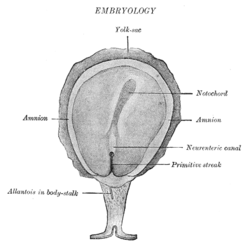Primitive groove
This article may be too technical for most readers to understand. (July 2018) |
| Primitive groove | |
|---|---|
 Surface view of embryo of Hylobates concolor. The amnion has been opened to expose the embryonic disk. | |
| Details | |
| Carnegie stage | 9 |
| Identifiers | |
| Latin | sulcus primitivus |
| Anatomical terminology | |
The primitive groove is a feature present during prenatal development. It is a shallow groove that appears on the surface of the primitive streak.[1][2] It is created by infolding of epiblastic cells.[1][2] Its anterior end communicates with the yolk-sac by means of the blastophore (an aperture).[citation needed]
References[]
![]() This article incorporates text in the public domain from page 47 of the 20th edition of Gray's Anatomy (1918)
This article incorporates text in the public domain from page 47 of the 20th edition of Gray's Anatomy (1918)
- ^ a b Moore, Keith L.; Persaud, T. V. N.; Torchia, Mark G. (2018). "4 - Third Week of Human Development". The Developing Human (11th ed.). Saunders. pp. 47–63. ISBN 9780323611541.
- ^ a b Standring, Susan (2020). "10 - Cell populations at gastrulation". Gray's Anatomy (42nd ed.). Elsevier. pp. 188–195. ISBN 9780702077050.
External links[]
- Swiss embryology (from UL, UB, and UF) hdisqueembry/triderm02
Categories:
- Wikipedia articles incorporating text from the 20th edition of Gray's Anatomy (1918)
- Developmental biology stubs
- Embryology